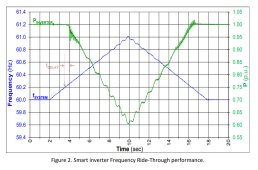Solar Guppy
Red Cobra Guppy
I've never figured out how that works with AC coupling. I know in the regular world the SCC just draws less power when the batteries are full, but microinverters are full-bore-full-time? Is that like the wall outlet analogy?
(For the newbies here... yeah... asking.. uhhh.. for a friend... yeah..)
Current codes ( UL1741-SA/-SB ) have specifications for maximum power output is a percentage of the operating line frequencies.
Here is a quick overview and here is where the concept evolved from and more on what frequency control is and even more technical artical on the subject.
Basically as the line frequency shifts from 60hz ( up or down ) the proportional outputs decline. From the IEEE 1547 is this image the is a good example of what this is:

Line Frequency is only one of dozens of parameters, what started out as UL1741 as a binary on/off on voltage window had become problematic as adoption grew it became a major concern that UL1741 was actually magnifying grid instability ( small blip, and megawatts of solar had to drop off line for 5 minutes ). Changes over the 20+ years have morphed into All GRIDTIE solar is now an extension of the utility which has become dependant on the energy in help improve stability.


